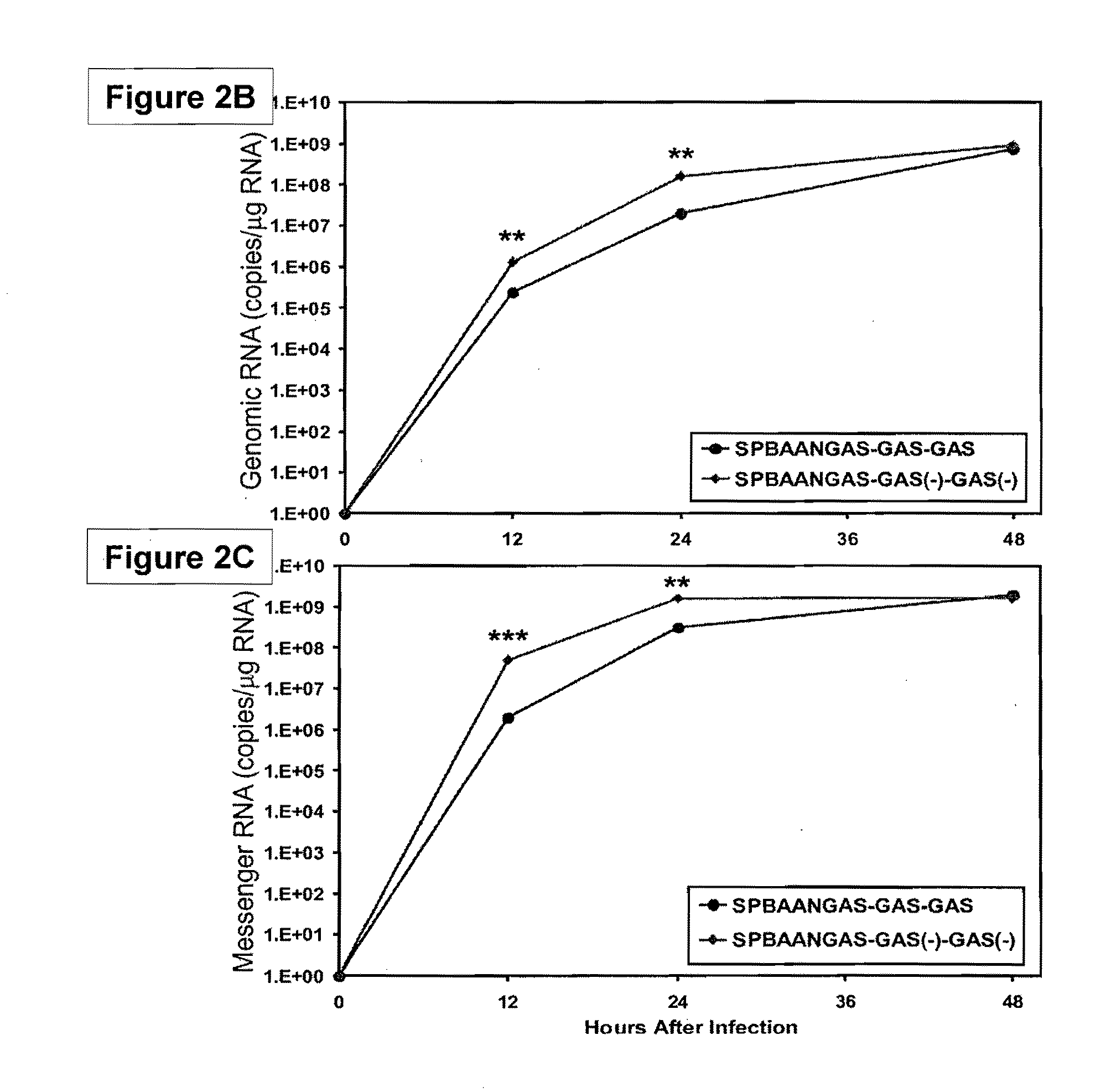Attenuated Live Triple G Protein Recombinant Rabies Virus Vaccine for Pre- and Post-Exposure Prophylaxis of Rabies
a rabies virus and live triple g protein technology, applied in the field of non-pathogenic rabies virus recombinant rabies virus vaccine, can solve the problems of preventing the production of disease, affecting the detection of rabies, and limiting the access to vaccination, so as to reduce the inability to produce disease.
- Summary
- Abstract
- Description
- Claims
- Application Information
AI Technical Summary
Benefits of technology
Problems solved by technology
Method used
Image
Examples
example 1
Construction and In Vitro Characterization of the Triple G (GAS) Recombinant Rabies Virus SPBAANGAS-GAS-GAS
[0126]The recombinant RVs were rescued from the cDNA clones as described (Faber et al., 2002, J Virol 76:3374-3381; Schnell et al., 1994, EMBO J 13:4195-4203), and the correct nucleotide sequences of the inserted genes were confirmed by reverse transcriptase PCR analysis and DNA sequencing. Recombinant RV vaccine SPBNGAS is based on the prototype recombinant virus SPBN, which was derived from the SAD B19 cDNA clone (Schnell et al., 1994, EMBO J 13:4195-4203). The generation of the double G variant of SPBN is described elsewhere (Li et al., 2008, Vaccine 26:419-426; Faber et al., 2002, J Virol 76:3374-3381). To facilitate insertion of a third GAS gene, AsiSI and AscI restriction sites were introduced into pSPBNGAS-GAS. A fragment between PacI and BsiWI of pSPBNGAS, containing regulatory and intergenic sequences, was amplified using Deep Vent polymerase (New England Biolabs) and ...
example 2
The Triple GAS RV Variant Has Limited Pathogenicity in Suckling Mice
[0131]To examine whether the presence of 3 GAS genes further decreases the pathogenicity in young mice of RV vaccine candidates, groups of 8-15 one-, five-, and ten-day-old Swiss-Webster mice were inoculated intracranial / intracerebrally (i.c.) with 103 focus-forming units (FFU) of SPBNGAS, SPBNGAS-GAS, SPBAANGAS-GAS-GAS, or SPBAANGAS-GAS(−)-GAS(−) (in 5 μl PBS) and observed for occurrence of clinical signs of rabies.
[0132]Although all 1-, 5-, or 10-day-old mice inoculated i.c. with SPBNGAS or SPBNGAS-GAS succumbed to infection between 6 and 10 days afterward, all five- and ten-day-old mice infected i.c. with SPBAANGAS-GAS-GAS did not develop any clinical signs of infection and survived (FIG. 3). Moreover, although all one-day-old mice infected with SPBAANGAS-GAS-GAS died, they died much later than SPBNGAS or SPBNGAS-GAS-infected one-day-old mice (8-11 days after infection). Notably, 100% and 60% of the five- and ten...
example 3
Immunogenicity of SPBAANGAS-GAS-GAS in Young and Adult Mice
[0133]In order to assess immunogenicity of triple GAS, mice were injected i.c. with 103 FFU of SPBNGAS, SPBNGAS-GAS, SPBAANGAS-GAS-GAS or SPBAANGAS-GAS(−)-GAS(−) in 5 μL PBS. One litter of 8-15 mice was used for each virus. Twenty-one days after infection, blood samples were obtained from the surviving mice and viral neutralizing antibody (VNA) titers were determined by using the rapid fluorescence inhibition test. Six 8-week-old Swiss-Webster or various mutant mice were infected i.c. under anesthesia with 5 μL PBS containing 107 FFU SPBNAAGAS-GAS-GAS, 100 50% i.c. lethal doses (IC-LD50) of DOG4 RV, or a mixture of 107 FFU of SPBNAAGAS-GAS-GAS and 100 IC-LD50 of DOG4 RV. Intramuscular (i.m.) infection of adult Swiss-Webster mice was performed under anesthesia by injecting PBS containing 10 50% i.m. lethal doses (IM-LD50) of DOG4 RV into the gastrocnemius (100 μL) or masseter (50 μL) muscles. After infection, mice were observ...
PUM
 Login to View More
Login to View More Abstract
Description
Claims
Application Information
 Login to View More
Login to View More - R&D
- Intellectual Property
- Life Sciences
- Materials
- Tech Scout
- Unparalleled Data Quality
- Higher Quality Content
- 60% Fewer Hallucinations
Browse by: Latest US Patents, China's latest patents, Technical Efficacy Thesaurus, Application Domain, Technology Topic, Popular Technical Reports.
© 2025 PatSnap. All rights reserved.Legal|Privacy policy|Modern Slavery Act Transparency Statement|Sitemap|About US| Contact US: help@patsnap.com



